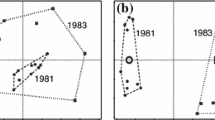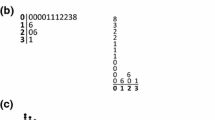Summary
The evaluation of ordination methods through simulated coenoclines is discussed. The inconsistency of some arguments against the use of linear ordinations is stressed. The regression between the product moment correlation coefficient and the relative overlapping area of the bellshaped curves of the species of coenoclines may be fitted to a linear function. An example of a seriation of relevés along a straight line based on a linear method is given using field data.
Similar content being viewed by others
References
Aart, P.J.M.van der & N., Smeenk-Enserink. 1975. Correlation between distributions of hunting spiders (Lycosidae, Ctenidae) and environmental characteristics in a dune area. Neth. J. Zool. 25: 1–45.
Anderson, A.J.B. 1971. Ordination methods in ecology. J.Ecol. 59: 713–726.
Austin, M.P. 1972. Models and analysis of descriptive vegetation data. In: J.N.R., Jeffers (ed.): Mathematical models in ecology, p. 61–86. Blackwell, Oxford.
Austin, M.P. 1976a. On non-linear species response models in ordination. Vegetatio 33: 33–41.
Austin, M.P. 1976b. Performance of four ordination techniques assuming three different non-linear species response models. Vegetatio 33: 43–49.
Austin, M.P. & I., Noy-Meir. 1971. The problem of non-linearity in ordination: experiments with two gradient models. J. Ecol. 59: 762–773.
Beals, E.W. 1973. Ordination: mathematical elegance and ecological naiveté. J. Ecol. 61: 23–35.
Dale, M.B. 1975. On objectives of methods of ordination. Vegetatio 30: 15–32.
Fcoli, E. 1976. Correlation between single ecological variables and vegetation by means of eluster analysis. Not. Fitosoc. 12: 77–82.
Feoli, E. 1977. On the resolving power of principal component analysis in plant community ordination. Vegetatio 33: 119–125.
Feoli, E. & L.Feoli, Chiapella. 1976. Due associazioni rupicole della Majella. Not. Fitosoc. 12: 67–75.
Feoli, Chiapella L. & E., Feoli. 1977. A numerical phytosociological study of the summits of the Majella massive (Italy). Vegetatio 34: 21–39.
Gauch, H.G.Jr. & R.H., Whittaker. 1972a. Coenocline simulation. Ecology 53: 446–451.
Gauch, H.G.Jr. & R.H., Whittaker. 1972b. Comparison of ordination techniques. Ecology 53: 868–875.
Gauch, H.G.Jr. & R.H., Whittaker. 1976. Simulation of community patterns. Vegetatio 33: 13–16.
Gauch, H.G.Jr., G.B., Chase & R.H., Whittaker. 1974. Ordination of vegetation samples by Gaussian species distribution. Ecology 55: 1382–1390.
Gauch, H.G.Jr., R.H., Whittaker & R.T., Wentworth. 1977. A comparative study of reciprocal averaging and other ordination techniques. J. Ecol. 65: 157–174.
Gittins, R. 1965. Multivariate approaches to a limestone grassland community. I. A stand ordination. J. Ecol. 53: 385–401.
Goodall, D.W. 1954. Objective methods for the classification of vegetation. III. An essay on the use of factor analysis. Austral. J. Bot. 2: 304–324.
Goodall, D.W. 1978. Sample similarity and species correlation. 2nd ed. In: R.H., Whittaker (ed.). Ordination of plant communites, p. 99–149. Junk, The Hague.
Gounot, M. 1969. Methodes d'étude quantitative de la végétation. Masson, Paris, 314 pp.
Gower, J.C. 1966. Some distance properties of latent root and vector methods used in multivariate analysis. Biometrika 53: 325–338.
Groenewould, H.van. 1976. Theoretical considerations on the covariation of plant species along ecological gradients with regard to multivariate analysis. J. Ecol. 64: 837–847.
Hill, M.O. 1973. Reciprocal averaging: an eigenvector method of ordination. J. Ecol. 61: 237–249.
Hill, M.O. & A.J.E., Smith. 1976. Principal component analysis of taxonomic data with multi-state discrete characters. Taxon 25: 249–255.
Ihm, P. & H.van, Groenewoud. 1975. A multivariate ordering of vegetation data based on Gaussian type gradient response curves. J. Ecol. 63: 767–777.
Kessel, S.R. & R.H., Whittaker 1976. Comparison of three ordination techniques. Vegetatio 32: 21–29.
Kruskal, J.B. 1964a. Multidimensional scaling by optimizing goodness of fit to a non-metric hypothesis. Psychometrika 29: 1–27.
Kruskal, J.B. 1964b. Non-metric multidimensional scaling: a numerical method. Psychometrika 29: 115–129.
Lotka, A.J. 1932. The growth of mixed populations: two species competing for a common food supply. J. Washington Acad. Sci. 22: 461–469.
Maarel, E.van der. 1969. On the use of ordination models in phytosociology. Vegetatio 10: 21–46.
Maarel, E.van der. 1971. Basic problems and methods in phytosociology. Rep. 14th Int. Symp. Rinteln 1970. Vegetatio 22: 269–273.
Maarel, E.van der. 1979. Transformation of cover-abundance values in phytosociology and its effects on community similarity. Vegetatio 39: 97–114.
Nichols, S. 1977. On the interpretation of principal component analysis in ecological contexts. Vegetatio 34: 191–197.
Noy-Meir, I. 1973. Data transformation in ecological ordination. I. Some advantage of non-centering. J. Ecol. 61: 329–341.
Noy-Meir, I. 1974. Catenation: quantitative methods for the definition of coenoclines. Vegetatio 29: 89–99.
Noy-Meir, I. & M.P., Austin. 1970. Principal component ordination and simulated vegetation data. Ecology 51: 551–552.
Noy-Meir, I., D., Walker & W.T., Williams, 1975. Data transformation in ecological ordination. II. On the meaning of data standardization. J. Ecol. 63: 779–800.
Noy-Meir, I. & R.H., Whittaker. 1977. Continuous multivariate methods in community analysis: some problems and developments. Vegetatio 33: 79–98.
Orlóci, L. 1966. Geometric models in ecology. I. The theory and application of some ordination methods. J. Ecol. 54: 193–215.
Orlóci, L. 1967. Data centering: a review and evaluation with reference to component analysis. Syst. Zool. 16: 208–212.
Orlóci, L. 1972a. On information analysis in Phytosociology. In: E.van der, Maarel & R., Tüxen (eds.), Grundfragen und Methoden der Pflanzensoziologie, Ber. Int. Symp. Rinteln 1970, p. 75–88. Junk, Den Haag.
Orlóci, L. 1972b. On objective functions of phytosociological resemblance. The American Mid. Natur. 88: 28–55.
Orlóci, L. 1974. On information flow in ordination. Vegetatio 29: 11–16.
Orlóci, L. 1978a. Multivariate analysis in vegetation research. Junk, The Hague, 2nd ed. 451 pp.
Orlóci, L. 1978b. Ordination by resemblance matrices. 2nd ed. In: R.H., Whittaker (ed.) Ordination of plant communities, p. 239–275. Junk, The Hague.
Orlóci, L. 1979. Non-linear data structures and their description. International Statistical Ecology Program. Parma 1978.
Phillips, D.L. 1978. Polynomial ordination: field and computer simulation testing of a new method. Vegetatio 37: 129–140.
Shepard, R.N. & J.D. Carrol. 1966. Parametric representation of non-linear data structure. In: P.R. Krishnaiah (ed.), Multivariate analysis, p. 516–592. Academic Press.
Swan, J.M.A. 1970. An examination of some ordination problems by use of simulated vegetation data. Ecology 51: 89–102.
Stanek, W., J.K., Jeglum & L., Orlóci. 1977. Comparisons of peatland types using macronutrient contents of peat. Vegetatio 33: 163–173.
Volterra, V. 1931. Variations and fluctuations of the number of individuals in animal species living together. In: Chapman (ed.), Animal ecology with special reference to insects, pp. 409–448. Mc Grow-Hill, New York.
Werger, M.J.A. 1978. Vegetation structure in the southern Kalahari, J. Ecol. 66: 933–941.
Westhoff, V. & E.van der, Maaral. 1978. The Braun-Blanquet approach, 2nd ed. In: R.H., Whittaker (ed.), Classification of plant communities, Junk, The Hague, p. 287–399.
Whittaker, R.H. 1967. Gradient analysis of vegetation. Biol. Rev. 49: 301–264.
Whittaker, R.H. 1972a. Convergences of ordination and classification. In: E. van der Maarel & R. Tüxen (eds.). Grundfragen und Methoden der Pflanzensoziologie, Ber. Int. Symp. Rinteln 1970, p. 39–57.
Whittaker, R.H. 1972b. Evolution and measurement of species diversity. Taxon 21: 213–251.
Whittaker, R.H. & H.G., Gaueh, 1978. Evaluation of ordination techniques 2nd ed. In: R.H., Whittaker (ed.), Ordination of plant communities, p. 277–336. Junk, The Hague.
Author information
Authors and Affiliations
Additional information
The research was supported by a grant from the Italian CNR (Programma Finalizzato ‘Promozione Qualità dell'Ambientesottoprogetto Metodologie Matematiche e Basi di Dati’).
We would like to thank dr. M. Dale, dr. E. van der Maarel and prof. L. Orlóci for useful comments on the manuscript and Mr. A. Zampar for technical assistance.
Rights and permissions
About this article
Cite this article
Feoli, E., Chiapella, L.F. Evaluation of ordination methods through simulated coenoclines: Some comments. Vegetatio 42, 35–41 (1980). https://doi.org/10.1007/BF00048868
Accepted:
Issue Date:
DOI: https://doi.org/10.1007/BF00048868




